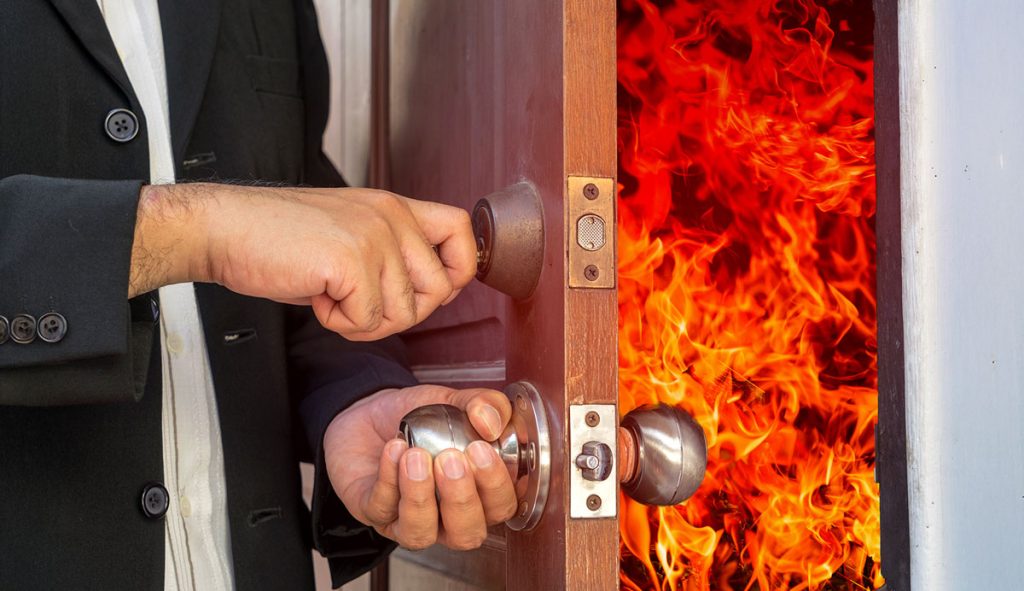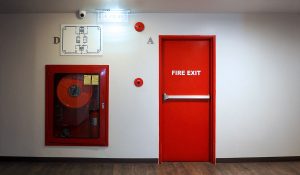Fire doors are an essential element of a building’s passive fire protection system, designed to save lives, protect property, and facilitate safe evacuation during a fire. Unlike regular doors, fire doors are specifically engineered to resist fire and smoke, compartmentalising a building into sections to slow the spread of flames and hazardous fumes. By doing so, they provide critical time for occupants to escape and for emergency services to respond effectively. In this blog, we delve into how fire doors work to prevent the spread of smoke and flames and why they are indispensable in fire safety strategies.
The Science Behind Fire Doors
To understand how fire doors prevent the spread of smoke and flames, it’s important to explore their unique design and components. Fire doors are made to meet stringent safety standards, enabling them to perform under extreme conditions. Key features include:
1. Fire-Resistant Materials
Fire doors are constructed from materials like solid timber, steel, or composite materials, which are resistant to high temperatures. These materials ensure the door remains intact and can withstand fire for a specified duration, such as 30 minutes (FD30) or 60 minutes (FD60).
2. Intumescent Seals
Intumescent seals are strips embedded in the edges of fire doors. When exposed to heat, these seals expand to fill any gaps between the door and its frame. This creates a barrier that prevents flames and hot gases from passing through, significantly reducing the spread of fire.
3. Smoke Seals
In addition to intumescent seals, many fire doors include smoke seals. These prevent the passage of cold smoke, which is one of the leading causes of fatalities in a fire. Smoke seals ensure that escape routes remain clear of toxic fumes, allowing occupants to evacuate safely.
4. Glazing
Some fire doors include fire-resistant glass panels. These are specially designed to maintain integrity under intense heat, preventing the spread of flames while providing visibility for safe navigation during an emergency.
5. Self-Closing Mechanisms
Fire doors are equipped with self-closing devices that ensure the door returns to a closed position after being opened. An open fire door cannot perform its function, making self-closing mechanisms crucial to fire safety.
Compartmentalisation: The Key to Containing Fire
One of the primary purposes of fire doors is to divide a building into fire compartments. Compartmentalisation involves creating sections within a structure that can contain fire and smoke for a set period, limiting its spread. Here’s how fire doors contribute to this strategy:
1. Delaying Fire Spread
By containing the fire within a single compartment, fire doors buy valuable time for occupants to evacuate and for firefighters to arrive. This delay also helps to protect critical areas, such as stairwells and evacuation routes, from becoming engulfed.
2. Preserving Escape Routes
Smoke is often more dangerous than flames during a fire, as it can quickly incapacitate individuals. Fire doors with smoke seals ensure that stairwells and corridors remain free of smoke, providing clear and safe escape routes.
3. Protecting Adjacent Areas
In multi-use buildings or residential complexes, fire doors prevent flames and smoke from spreading to other units or areas. This containment reduces the overall damage to the property and helps safeguard lives.
Legal and Regulatory Requirements for Fire Doors
In the UK, fire doors must comply with strict legal and regulatory requirements to ensure their effectiveness. These include:
1. Fire Resistance Ratings
Fire doors are tested and certified to withstand fire for a specific duration. The most common ratings are FD30 (30 minutes) and FD60 (60 minutes). The rating required depends on the building’s design and purpose.
2. Building Regulations (Part B)
Part B of the Building Regulations specifies where fire doors should be installed and their minimum performance standards. This includes requirements for doors in escape routes, stairwells, and areas separating high-risk zones from the rest of the building.
3. Maintenance and Inspection
Fire doors must be regularly inspected and maintained to ensure they remain in good working condition. Damaged or poorly maintained fire doors cannot provide adequate protection, compromising the building’s fire safety.
The Importance of Proper Installation
Even the best fire door will fail if it is not installed correctly. Professional installation is critical to ensure that:
- The door fits snugly within its frame, with gaps no larger than 3mm to 4mm.
- Intumescent seals are properly positioned and intact.
- Self-closing mechanisms function correctly and reliably.
Improper installation can render a fire door ineffective, increasing the risk to occupants and property.
The Consequences of Neglecting Fire Doors
Failing to install, maintain, or use fire doors properly can have severe consequences, including:
1. Increased Fire Spread
Without functional fire doors, fire and smoke can spread rapidly through a building, endangering lives and causing extensive property damage.
2. Legal Penalties
Non-compliance with fire safety regulations can result in significant fines, legal action, and potential closure of a building.
3. Insurance Issues
Many insurers require evidence of compliance with fire safety standards. Inadequate fire protection measures, including faulty or missing fire doors, could void insurance claims in the event of a fire.
Real-World Examples of Fire Doors Saving Lives
Fire doors have proven their effectiveness time and again in real-world scenarios. For instance, in large residential fires, well-maintained fire doors have contained the blaze to a single unit, allowing occupants of other units to evacuate safely and reducing property damage. These examples underscore the importance of ensuring fire doors are properly installed and maintained.
Tips for Ensuring Your Fire Doors Perform Effectively
To maximise the safety provided by fire doors, consider the following tips:
- Conduct Regular Inspections: Check for visible damage, such as cracks, warping, or gaps.
- Test Self-Closing Mechanisms: Ensure doors close fully and latch securely.
- Replace Worn Components: Damaged intumescent seals or hinges should be replaced promptly.
- Educate Occupants: Inform building users about the importance of keeping fire doors closed and not obstructing them.
Conclusion
Fire doors are a vital part of any fire safety plan, preventing the spread of smoke and flames, protecting escape routes, and saving lives. Their effectiveness relies on proper design, installation, and maintenance, as well as compliance with relevant regulations. By prioritising the upkeep and inspection of fire doors, building owners and managers can ensure the safety of occupants and the protection of property.
At Original Fire, we specialise in the installation and maintenance of high-quality fire doors. Contact us today to learn more about how we can help you enhance your building’s fire safety and compliance.



